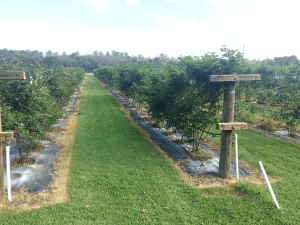Interested in trying to grow thornless blackberries? Are they a good crop here? The Arkansas breeding program with Dr. John Clark is the source for the majority of new blackberry cultivars on the market. Arkansas conditions are not the same as ours, so it is amazing that these cultivars work here at all. There are several growers who have been successful with this crop, but more who have not.
Blackberry Basics
Blackberries have perennial roots, but biennial tops. That means the canes grow vegetatively the first year (primocanes), and produce flower buds and fruit the second year (floricanes) after winter chilling. The floricanes are pruned back to the ground after harvest while new primocanes grow up. Primocane tips that touch the soil will root in as the canes grow. Summer prune to avoid this problem, or an impenetrable briar patch will result. Summer pruning also stimulates more branches on the primocanes, providing more sites for flowering (larger crop) the following year.
Trellising

Long, flexible primocanes require some type of trellis. This can be as simple as a T shaped support with wires on either end of the T that you keep the canes growing up through. Some prefer a V-shaped trellis where they train the primocanes to one side and the floricanes to the other, tying them to the wire on their respective sides. Cutting the floricanes after flowering is easier with the V trellis because you don’t have to sort through the canes to separate the floricanes from the primocanes.
Chilling
Current blackberry cultivars do need some amount of chilling in the winter to stimulate flowering the second year. Many cultivars may not perform well here because they are not adapted to our warmer climate. Dr. Shinsuke Agehara at the Gulf Coast Research and Education Center in Balm, is working on using plant hormones to overcome dormancy so that more places in Florida can grow thornless blackberries. At the same time, Dr. Zhanao Deng is working on blackberry breeding and evaluation of current cultivars. However, it will be a few years before we can expect some results from this work.
What Can We Do Now?
Several commercial growers have had success with ‘Arapaho’, ‘Ouachita’, and ‘Osage’, but it may be because of their microclimate, soils, or management practices. There are several diseases and insects that will plague Florida blackberries. More on that in another post.
The Arkansas breeding program recently released new “primocane-fruiting” thornless blackberries. These blackberries fruit on the tips of the primocanes in the fall, and continue fruiting the second year when the canes become floricanes, producing two crops. Primocane fruiting types can also be grown as an annual crop with perennial roots if you sacrifice the floricane crop. After primocane fruiting is finished in the winter, the canes can be removed and the next year new primocanes will emerge to provide fruit.
This system seems like it might be ideal for our area, but we have not had time to test it out. Theoretically, the roots will still need chilling to continue to produce vigorous canes. Also, I have heard reports that the primocanes do not produce flowers in our excessive summer heat. So we don’t know when the fall crop of fruit will be produced, if at all, in our area. I hope to do some trials on these next year to see what can be done while we wait for our UF researchers to come up with a better solution.
 0
0
